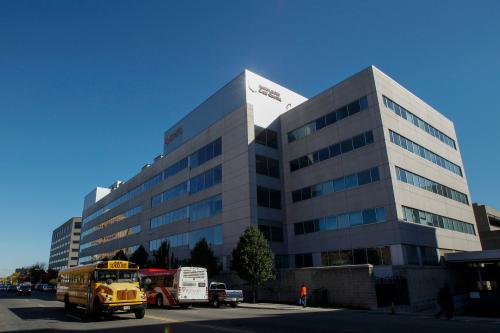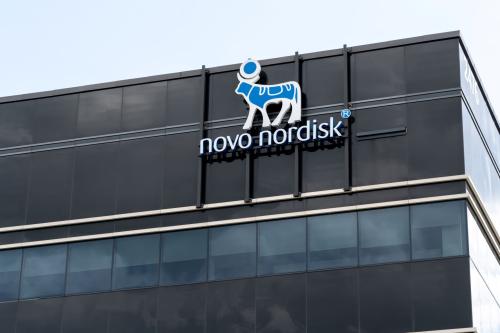This analysis is part of the USC-Brookings Schaeffer Initiative for Health Policy, which is a partnership between the Center for Health Policy at Brookings and the University of Southern California Schaeffer Center for Health Policy & Economics. The Initiative aims to inform the national health care debate with rigorous, evidence-based analysis leading to practical recommendations using the collaborative strengths of USC and Brookings. This article originally appeared in Health Affairs on September 25, 2018.
Surprise medical bills – those from out-of-network physicians that patients had no role in choosing – are not a new phenomenon, but national attention to the issue has grown tremendously in recent years, likely due to increased incidence and larger bills. Surprise bills arise most often during emergency care or during elective care involving ancillary physicians (such as radiologists, anesthesiologists, pathologists) who patients don’t actively choose and are not in the insurer’s provider network. Multiple studies have found that roughly one in five emergency department visits involved care from an out-of-network physician, as well as a not-insignificant share of elective inpatient admissions at in-network facilities. And these surprise bills can be quite large.
Many states across the political spectrum have taken steps to mitigate this problem, including a handful in just the last two years: Arizona, Missouri, New Hampshire, New Jersey, and Oregon. However, current state laws do not apply to the roughly half of privately-insured Americans enrolled in so-called “self-insured” health plans that are common among large employers, because the Employee Retirement Income Security Act (ERISA) precludes states from regulating these plans. While there are policies states could pursue to mitigate surprise out-of-network billing for their residents in self-insured plans as well, which we will explore in a future paper, we do not know of any states that have taken such an approach.
Federal action, therefore, may prove necessary to protect people enrolled in self-insured employer health plans, as well as all privately-insured individuals in the majority of states that have not enacted comprehensive surprise billing legislation. Such federal regulation of self-funded health plans has well-established precedent. For example, as we described previously in a Health Affairs Blog post:
Federal law currently requires all health plans, including self-funded ones, to: 1) cover mental health care on par with physical health care; 2) cover recommended evidence-based preventive care services without any cost sharing from patients; 3) avoid caps on total coverage amounts; 4) cover patient services provided through approved clinical trials; and 5) contribute to public funding of health services research. Preventing surprise medical billing under self-funded plans would only modestly modify the existing scope of federal requirements yet provide substantial protections that are needed to avoid systematic unfairness.
On September 18, a bipartisan group of six Senators – Michael Bennet (D-CO), Tom Carper (D-DE), Bill Cassidy (R-LA), Chuck Grassley (R-IA), Claire McCaskill (D-MO), and Todd Young (R-IN) – took such action, releasing draft legislation to protect patients in both insured and self-insured plans from these surprise out-of-network bills. Titled the “Protecting Patients from Surprise Medical Bills Act,” the draft legislation represents only the second near-comprehensive Congressional bill to address the issue (Representative Michelle Lujan Grisham’s “Fair Billing Act of 2017” being the other).
Protecting Patients from Surprise Medical Bills Act
The bipartisan draft legislation includes three important components that would jointly protect consumers from surprise medical bills:
- Limiting patient cost-sharing to the amount they would owe to an in-network provider;
- Setting a payment standard regarding what insurers owe providers in these situations; and,
- Prohibiting providers from balance billing patients.
The legislation would address the two main situations in which surprise out-of-network bills frequently arise:
- Out-of-network emergency care; and
- Out-of-network care, typically from ancillary physicians, delivered at an in-network facility (e.g., a hospital or ambulatory surgical center).
Additionally, once a patient is stabilized following emergency care at an out-of-network facility, the patient must be notified about the potential for higher cost-sharing if they remain at the current facility and provided the option to transfer to an in-network facility.
Critically, the bill’s protections would automatically kick in when either of these two situations occur, without the patient having to take any action. The patient would be required only to pay the standard amount they would have owed if the service in question was performed by an in-network physician and balance billing would be prohibited. The patient’s health plan, then, would have to pay the provider an amount determined by the state (or locality) in which the service was performed. If a state does not elect a payment methodology, then the federal default would require the health plan to pay (less the patient cost-sharing) the greater of:
- The median in-network contracted rate for the service in a specified geographic area (the draft legislation does not specify from which data this median rate would be calculated); or
- 125 percent of the average allowed amount for the service in a specified geographic area, as determined by the most recent year of data available from a “statistically significant benchmarking database maintained by a nonprofit organization,” such as FAIR Health, Health Care Cost Institute, or a state’s all-payer claims database if administered by a nonprofit.
The out-of-network physician, therefore, would have to accept this amount as payment in full. It is unclear why both of these options were included, as the second option will almost always be higher than the first.
This approach is broadly similar in structure to surprise billing laws in California and Connecticut, which similarly combine a regulation on the health plan to treat the “surprise” out-of-network service as in-network, a prescribed rate that the health plan must pay to the provider, and a prohibition on the provider from balance billing the patient above their standard in-network cost-sharing amounts. Other states with near-comprehensive laws, such as Illinois, New Jersey, New Hampshire, and New York, and Representative Lujan Grisham’s “Fair Billing Act of 2017” take a similar approach, but instead of directly prescribing a payment rate from health plan to provider, leave that determination up to a binding arbitration process.
Notably, this approach goes beyond what was included in the Affordable Care Act (and subsequent rulemaking), which, for emergency care, limited patient coinsurance and copayments to in-network rates (although the out-of-network deductible and out-of-pocket limit would still apply) and required insurers to pay providers a minimum rate, but did not prohibit these providers from balance billing patients.
Because this current proposal would prohibit balance billing, it would effectively cap total payments to providers at a particular payment rate. Under this type of approach, then, a key question becomes how to determine the appropriate payment rate.
Areas for Further Consideration
The rest of this blog discusses changes that should be considered as Senators work on revising this discussion draft, specifically with respect to (1) determining the appropriate payment rate, (2) which types of physicians the bill’s protections should apply to, and (3) the possibility of expanding protections to ambulance services.
Determining the “Appropriate” Payment Rate
We believe that the option of “at least” 125 percent of average allowed amounts is unnecessarily high and would drive up insurance premiums and potentially have counterproductive impacts on contracting decisions. Emergency care and ancillary physicians, for whom the patient typically has little to no role in choosing, may have little incentive to join insurer networks if they are guaranteed payments of 125 percent of the average allowed amounts when they remain out-of-network. Additionally, to the extent any similar bill defines payment based on a percentile of average contracted rates or allowed amounts, unintended impacts on future contract negotiations can be minimized by tying the rate to a point in time before passage of the bill, inflated forward by the Consumer Price Index or something similar.
Determining the “appropriate” rate, though, is difficult. It is clear that payment should not be tied in any way to providers’ billed charges, which are largely untethered by market forces and tend to be extremely high in relation to Medicare’s payment rates, especially for specialties most commonly involved in surprise out-of-network billing. That charges are particularly high for these specialties is not a coincidence, as billed charges are primarily only assessed to the uninsured and patients receiving out-of-network medical care (insurers negotiate lower contracted rates for their enrollees receiving in-network care). For specialties where the patient has little or no choice among physicians, there’s an incentive to charge high amounts both because the physician (or the physician’s employer) can assess these charges to unsuspecting out-of-network patients and because the threat of doing so helps them obtain higher in-network contracted rates from health plans. Indeed, using data from provider charges reported to Medicare, Ge Bai and Gerard Anderson find that median charges for emergency medicine, anesthesiology, radiology, and pathology are all at least 400 percent of Medicare rates.
The two main options are to tie payment rates in “surprise” out-of-network situations to some percentage of Medicare rates or average (mean or median) in-network contracted rates (either specific to the patient’s health plan or averaged across all health plans in a region) for the service. Or, like in California, the rate could be set at the greater of two options.
Medicare rates have the benefit of being tied to the government’s best attempt at determining the relative value of different services and can easily be scaled up or down depending on policymaker preferences. Average in-network payment rates notionally have the benefit of being tied to an existing market price, but that premise is flawed with respect to emergency care and ancillary physician services, where network rates are artificially high today because patients lack choice and hence the normal dynamics of negotiating lower rates in exchange for higher volume largely do not apply. While we do not know of concrete data on the question, two studies have found average in-network rates for emergency care in commercial plans to be at roughly 300 percent of Medicare rates. And at least for certain services, two studies have found average in-network rates for radiologists in commercial plans to be at roughly 200 percent of Medicare rates. Both of these are relatively high compared to average in-network rates negotiated by most physician specialties.
Alternatively, as we discuss in more detail in a 2016 paper, policymakers could introduce a “baseball-style” binding arbitration process to determine the appropriate rate. In this process, an arbitrator chooses the more reasonable of the parties’ final positions instead of specifying a compromise, which should promote settlement. Or this decision could be avoided altogether by placing the onus on the hospital to pay ED and ancillary physicians directly and build those costs into their facility rate negotiated with a health plan, similar to how nursing services are treated today. Yale Professors Zack Cooper and Fiona Scott Morton have recommended an approach along these lines, with the goal of using the market to determine rates in these situations.
How Broadly Should Surprise Billing Protections Apply?
The case for protecting patients in emergency situations who are seen by a physician outside of their insurer’s network is relatively straightforward—markets cannot work when the consumers have no choices. Similarly, when receiving elective care at an in-network facility from an in-network physician, the patient does not have any reasonable choice of the ancillary clinicians – or often the neonatologist or assistant surgeon – who might be involved in her care, and thus should not be held liable for higher cost-sharing if that clinician was outside of her health plan’s provider network. The draft legislation, however, would apply its protections to all out-of-network care delivered at an in-network facility without any exception for obtaining patient consent, which is likely too broad of a restriction. No patient consent exception is needed for out-of-network ancillary care at an in-network facility, but for other types of physicians, there are legitimate instances—for example, a surgeon – where, before admission, a patient proactively chooses to see an out-of-network physician at that facility.
Ambulances
One notable omission from the discussion draft is any protection from out-of-network ambulance bills. In a study of large employer health plan claims, Christopher Garmon and Benjamin Chartock found that roughly half of all ambulance rides were billed out-of-network. As the Senators work on revising this legislation, they should consider applying a similar approach as is used for out-of-network emergency care for ambulance rides.
Conclusion
This bipartisan draft legislation marks an important step forward in putting an end to surprise out-of-network medical bills nationwide. As work proceeds on this issue, lawmakers should focus on:
- Determining the appropriate payment rate from the health plan to the provider in these instances, specifically considering a lower rate than the 125 percent of average allowed amounts in a region currently in the draft (and if using any percentile of average allowed or contracted amounts, pegging this calculation to a point in time before passage of the bill, inflated forward);
- Narrowing the protection for all out-of-network services at an in-network facility to those most likely to involve surprise bills; and
- Adding a protection for out-of-network ambulance bills.
Additional resources on surprise billing are available here.
Through a grant from the Laura and John Arnold Foundation, Brookings is working to critically evaluate the prevalence, drivers, and policy implications of surprise medical billing, as well as develop potential nonpartisan policy solutions.
This post was updated in November 2018 to further clarify the description of the ACA’s requirements for coverage of out-of-network emergency care.












Commentary
Analyzing new bipartisan federal legislation limiting surprise medical bills
September 25, 2018